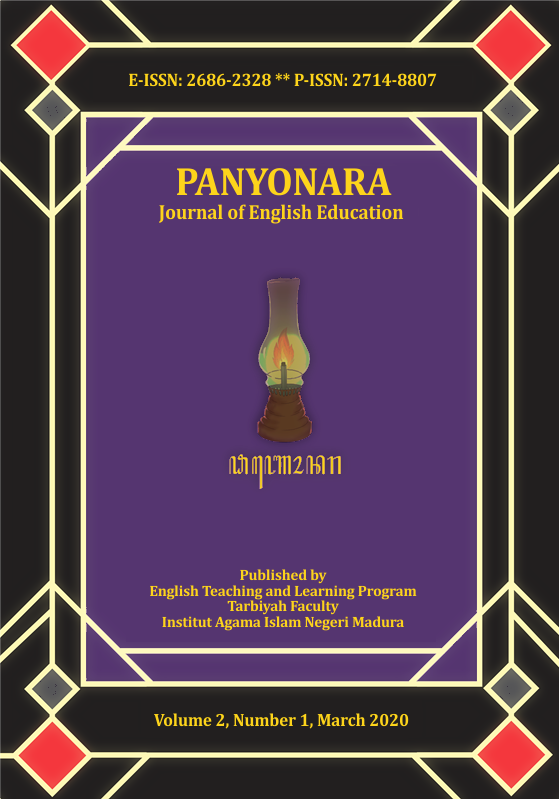The Comparison between Male and Female Students in Reading Comprehension Achievement at the Third Semester of TBI STAIN Pamekasan
 Abstract views: 520
,
Abstract views: 520
,
 PDF downloads: 551
PDF downloads: 551
Abstract
The students of STAIN Pamekasan consist of male and female students. Each of them shows different abilities. Male students generally have a good performance on spatial tasks and mathematical achievement. While, female students are superior in some aspects such as mathematic calculation, vocabulary, found an idea, memorizing, and making a relation, several verbal skills, reading, and writing. This study examines to know the different achievements between male and female students in reading comprehension in the third semester of TBI STAIN Pamekasan and to measure the statistically significant difference between male and female students in reading comprehension achievement at the third semester of TBI STAIN Pamekasan. This research is designed with ex-post facto. The population is 210 students, and 82 students were chosen as sample. The research instruments were tests and documentation. The quantitative data will be analyzed using a t-test. The result showed that there is no difference between male and female students in reading comprehension achievement in the third semester of TBI STAIN Pamekasan. t-value is lower than t-table [-1,226 <2,64 (1%)] [1,226 <1,99 (5%)]. Based on the result above, the lecturer needs to pay attention more to the students’ improvement in studying English, especially in reading comprehension
Downloads
References
Al-Shumaimeri, Y.A. (2005). Gender Differences in Reading Comprehension Performance in Relation to Content Familiarity of Gender-Neutral Texts. Presented at the Second International Conference: Language, Culture and Literature., Minia University, Egypt.
Broughton, G., Brumfit, C., Flavell, R., Hill, P., & Pincas, A. (2003). Geoffrey Broughton, et. al, Teaching English as a Foreign Language (Taylor and Francis: Routledge, 2003), 89-90. London and New York: Routledge.
Carell, P., & Grabe, W. (2010). An Introduction to Applied Linguistics. London: Hodder Education.
Chaer, A. (2009). Psikolinguistik Kajian Teoritik. Jakarta: Rineka Cipta.
Creswell, J. W. (2012). Educational Research: Planning, Conducting and Evaluating Quantitative and Qualitative Research. USA: Pearson Education.
Ellis, R. (1994). The Study of Second Language Acquisition. Oxford: Oxford University Press.
Harmer, J. (2010). How to Teach English. England: Pearson Education.
Hidayah, R. (2012). Profil Kemampuan Membaca Siswa Kelas 5 Sekolah Dasar (Sd) dan Madrasah Ibtidaiyah (Mi) Ditinjau dari Jenis Sekolah dan Jenis Kelamin. Universitas Islam Negeri Maulana Malik Ibrahim.
Holmes, J. (2001). An Introduction to Sociolinguistics. Harlow: Longman.
Janson, E. (2010). Guru Super and Super Teaching. Jakarta: PT Indeks.
Lynn, R., & Mikk, J. (2009). Sex Differences in Reading Achievement. Trames, (13), 3–13.
Nunan, D. (1991). Language Teaching Methodology: A textbook for teachers. New York: Prentice Hall International.
Scanlon, D. M., Anderson, K. L., & Sweeney, J. M. (2010). Early Intervention for Reading Difficulties: The Interactive Strategies Approach. New York: The Guilford Press.
Sudijono, A. (2011). Pengantar Statistik Pendidikan. Jakarta: Rajawali Press.
Thonis, E. W. (1970). Teaching Reading to Non-English Speakers. New York: Collier Macmillan Publisher.
Vaughn, S. R., & S. Bos, C. (2012). Strategies for Teaching Students with Learning and Behavior Problems. New Jersey: Pearson Education.
Zembar, L. B., & Blume, L. B. (2011). Gender and Academic Achievement. Retrieved from www.education .com/Reference/Article/Gendertoacademytoachievement
The journal uses an Open Access policy under a Creative Commons Attribution-NonCommercial 4.0 International License. Authors who publish with this journal agree to the following terms:
- Authors retain copyright and grant the journal right of first publication with the work simultaneously licensed under a Creative Commons Attribution License that allows others to share the work with an acknowledgment of the work's authorship and initial publication in this journal.
- Authors are able to enter into separate, additional contractual arrangements for the non-exclusive distribution of the journal's published version of the work (e.g., post it to an institutional repository or publish it in a book), with an acknowledgment of its initial publication in this journal.
- Authors are permitted and encouraged to post their work online (e.g., in institutional repositories or on their website) prior to and during the submission process, as it can lead to productive exchanges, as well as earlier and greater citation of published work.
















